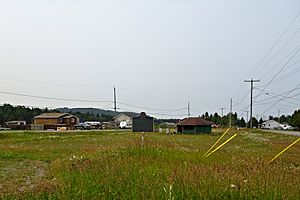Biigtigong Nishnaabeg facts for kids
Quick facts for kids
Pic River 50
|
|
|---|---|
| Pic River Indian Reserve No. 50 | |
 |
|
| Country | Canada |
| Province | Ontario |
| District | Thunder Bay |
| First Nation | Biigtigong Nishnaabeg |
| Area | |
| • Land | 3.65 km2 (1.41 sq mi) |
| Population
(2011)
|
|
| • Total | 395 |
| • Density | 108.3/km2 (280/sq mi) |
| Website | www.picriver.com |
Biigtigong Nishnaabeg is a First Nation community. They are part of the Ojibway (or Anishinaabe) people. This community is located on the northern shore of Lake Superior. People sometimes call them the Ojibways of the Pic River First Nation, or just "Pic River" for short.
The community is found at the mouth of the Pic River. This area is known as Pic River 50. In 2007, there were 964 registered members. About 480 of these members lived on the reserve.
Contents
A Look at Pic River History
The area where the Pic River meets Lake Superior has been important for thousands of years. It was a key spot for trade and settlement. This location was great for water travel. It gave access to northern lands and a canoe route to James Bay.
European maps first showed "the Pic" in the mid-1600s. It was a halfway point for canoe travelers along Lake Superior's north shore.
Early Trade and Settlement
Local First Nations people traded furs with the French as early as the 1770s. A French fur trader set up a permanent trading post around 1792. The Hudson's Bay Company also had a post there starting in 1821.
In 1879, the Pic River community asked for their own reserve land. Their request was granted. In 1914, Pic River 50 officially became a treaty-established reserve.
Life on the Pic River 50 Reserve
Pic River 50 is an Indian reserve located on the north shore of Lake Superior. It is at the mouth of the Pic River, close to Marathon, Ontario, Canada. The reserve covers about 316.6 hectares (782 acres) of land.
Generating Power and Jobs
Pic River 50 is known for its role in developing "run of the river" hydroelectric projects. These projects use the natural flow of rivers to create electricity. The community is a partner in three such projects:
- The 13.5 MW Black River generating station.
- The 5.0 MW Twin Falls generating station.
- The 23.0 MW Umbata Falls generating station.
Together, these projects make enough electricity for about 30,000 homes in Ontario.
The Ojibways of the Pic River First Nation are working to make their reserve self-sufficient. This means creating jobs, education, and resources within their own community. They have a successful forestry company. They also run a cable television company and a high-speed internet company.
Nature and Wildlife
The Pic River 50 reserve is home to many wild animals found in Northern Ontario. You might see beavers, moose, and woodland caribou. Other animals include wolfs, black bears, and white-tailed hawks. Birds like the bald eagle and northern flicker also live here.
The shores of Pic River 50 have large sandy dunes. These are especially noticeable on the Little Pic River. The name "Little Pic" means "little muddy."
Culture and Community Events
Pic River hosts an annual pow wow every year in mid-July. A pow wow is a special gathering where Indigenous people celebrate their culture. It often includes dancing, singing, and drumming.
The First Nation is also active in growing its economy and creating jobs. They have interests in hydroelectric plants on the Kagiano River and Black River. One of these is called the Wawatay Generating Station.
How the Community is Governed
The community of Biigtigong Nishnaabeg is led by a council. The current leadership includes Chief Duncan Michano and 11 councillors. Their term began on October 30, 2021, and lasts for four years.
Notable People from Pic River
- Rod Michano is a well-known activist. He works to raise awareness about HIV/AIDS among First Nations people.
Images for kids



